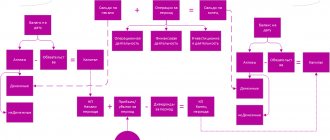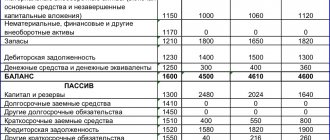Statistical form 12-F is used by Rosstat to collect information on expenses and deductions of own funds by business entities in the reporting period, according to the classification given in the form. In this review, we will explain the algorithm for working with the document, what the new form 12-F statistics “Information on the use of funds” is, approved by order of Rosstat, we will consider filling out form 12-F in its new edition and the features of generating statistical data in accordance with regulatory guidelines. We will also provide a new form 12-F (form), which you can download at the end of this article.
Concept of form, who passes
Form 12-F is a document that every organization must submit to the state statistics agency according to the region in which the enterprise operates. To be fair, it should be noted that there are so-called exceptions to the rule.
The following types of business entities are not required to submit this form:
- Small businesses. Let me remind you that small enterprises include enterprises with no more than one hundred employees, with annual revenue of no more than 800 million and with a limited share of participation in such an enterprise by other persons.
- Non-state pension funds;
- Banks and other credit organizations;
- State and municipal institutions;
- Insurance companies.
Important! If an enterprise has separate divisions - branches or representative offices, then such divisions must submit this report at the place of business activity.
Purpose of reporting
The analyzed form is a document submitted annually to the Russian Statistics Department by all legal entities. The exception is legal entities related to small businesses, the public sector, financial institutions, insurance companies and non-state pension funds.
With the help of 12-F, the Russian Statistics Department receives information about the mode of use by a legal entity of financial resources belonging to it during the reporting period according to the classification of expenses and deductions specified in the parsed form.
If a company has subsidiaries, regardless of the parent unit, each of them must individually provide the information required by the reporting.
Legislative regulation
Form 12-F in its modern version was approved by Rosstat Order No. 509 dated August 1, 2017. A sample of it can be downloaded here:
Form 12 f
This order of Rosstat describes in detail who must submit 12-F reports, what exceptions there are, and also provides detailed recommendations for filling out this declaration.
Important! Form 12-F is precisely a statistical form of monitoring the activities of business entities and is not a tax return.
How does a bill of lading differ from a transport bill of lading and a bill of lading?
A consignment note is issued when registering transactions for the purchase and sale of inventory items, regardless of whether a third-party organization is involved in transporting the goods or not. Unlike transport and consignment notes, it does not include information to record the movement of goods, transport work and payments for transportation.
Number of copies of technical specifications required
The technical specification is drawn up for one or several consignments of cargo, which are transported on one vehicle. According to the RF Regulation No. 272 dated April 15, 2011, the transport invoice is issued in triplicate. One remains with the shipper, the second is transferred to the recipient and the last remains with the carrier.
Methods for filing a declaration
This report form can be taken to the statistics agency during a personal visit or sent using an electronic submission form. The submission deadline is the same for both electronic submission and paper submission of the report.
Important! If you submit a report in paper form, print out two copies of the report and ask the specialist who accepted this document from you to put a mark on your copy indicating that the statistics agency accepted this report from you. This is done so that if the statistics authorities lose your report, you will have proof that you submitted it.
Important! If a report on Form 12-F is not submitted, the statistics agency may impose a fine on the organization that did not provide the document.
An error occurred.
not validEdited by 31.07.1996
detailed information
| Name of document | DECREE of the State Statistics Committee of the Russian Federation dated July 31, 1996 N 91 “On PRESERVATION OF THE FORM OF STATE STATISTICAL REPORTING ON THE STATE OF LABOR CONDITIONS AND APPROVAL OF INSTRUCTIONS FOR ITS COMPLETION” |
| Document type | resolution, instruction |
| Receiving authority | State Statistics Committee of the Russian Federation |
| Document Number | 91 |
| Acceptance date | 01.01.1970 |
| Revision date | 31.07.1996 |
| Date of registration with the Ministry of Justice | 01.01.1970 |
| Status | It does not work |
| Publication |
|
| Navigator | Notes |
INSTRUCTIONS FOR COMPLETING THE FORM OF STATE STATISTICAL REPORTING ON THE STATUS OF WORKING CONDITIONS, BENEFITS AND COMPENSATIONS FOR WORK IN UNFAVORABLE WORKING CONDITIONS (FORM N 1-T (WORKING CONDITIONS))
1. Information in form N 1-t (working conditions) is submitted by enterprises and organizations of industry, construction, transport and communications, regardless of the organizational and legal form and form of ownership (hereinafter referred to as organizations).
Information is provided for all personnel of the organization and for all categories of employees: workers, managers, specialists, employees.
The number of women on maternity leave and childcare leave until they reach the age of three is not included in the data on lines 01 - 21.
Section I. State of working conditions
2. The basis for filling out lines 02 - 09 are the results of certification of workplaces for working conditions, sanitary and technical certification of the working conditions of the workshop or special measurements of the parameters of sanitary and hygienic factors of working conditions.
The list of harmful production factors is determined by GOST 12.0.003-74 SSBT “Hazardous and harmful production factors. Classification". These are increased levels of noise, vibration, dust and gas contamination in the air of the working area, ionizing and non-ionizing radiation in the working area, unfavorable temperature conditions in the premises, insufficient illumination of workplaces, etc.
The assessment of working conditions is determined in accordance with the Hygienic criteria for assessing working conditions (in terms of harmfulness and danger of factors in the working environment, the severity of the production process), approved by the State Committee for Sanitary and Epidemiological Supervision of Russia 07/12/94 N R2.2.013-94.
3. Line 02 shows the number of employees in whose workplaces the actual value of at least one harmful (physical, chemical, biological) production factor exceeds its sanitary and hygienic standard.
According to line 02, each worker is counted only once, regardless of the number of dangerous and harmful production factors affecting him.
4. Lines 03 - 08 show workers whose workplaces noise, vibration, non-ionizing radiation exceed the established maximum permissible levels, dust and gas contamination of the air in the work area exceed the maximum permissible concentrations of harmful substances or industrial dust, ionizing radiation exceeds the standard dose rate for external irradiation . The same employee can be accounted for on several lines if he is simultaneously affected by a number of factors indicated in lines 03 - 08.
Filling out the form
Completing the cover page of Form 12-F includes making entries about:
- The name of the organization submitting the declaration (including full and short names);
- Address of the location of the enterprise;
- OKPO code of the organization. Note that the OKPO code, like other statistics codes, can be found on the state statistics website by indicating there your taxpayer identification number or ORGN;
- The year for which the report was compiled.
After filling out the title page, we proceed to filling out the form itself, which consists mainly of listing expenses, that is, how the company’s funds were spent in the reporting year.
Expenses are divided into main groups and their subgroups.
These main spending groups include: (click to expand)
- Entertainment expenses;
- Business maintenance expenses;
- Employee benefits;
- Financing investments on a long-term basis.
For each expense item and its subitem, you must indicate the amount of money spent by the legal entity.
Important! In this form of statistical observation, you need not only to indicate the presence and amount of money spent, but also to separate from the amount of expenses the amount of money spent from net profit.
We sign Form 12-F by the director of the organization or another person who is appointed as the unified executive body of the organization and is responsible for submitting statistical reports.
Results
The Russian statistics bodies, implementing the plan for maintaining statistical records, oblige legal entities to create and provide statistical reports that control finances. For this, in addition to other reporting documents, 12-F is used, effective from August 31, 2021. The completed form is equal to an official document and is submitted to the territorial body of Rosstat at its location.
Form No. 12-f “Information on the use of funds” (annual).
Federal statistical observation form No. 12-F “Information on the use of funds” is provided by all legal entities that are commercial organizations, as well as non-profit organizations of all forms of ownership that produce goods and services for sale to other legal entities (except for small businesses, state and municipal institutions, banks, insurance and other financial and credit organizations) at their location.
Bankrupt organizations that have entered bankruptcy proceedings are not exempt from providing information in the specified form. Only after the arbitration court has issued a ruling on the completion of bankruptcy proceedings in relation to the organization and the entry of its liquidation into the unified state register of legal entities (clause 3 of Article 149 of the Federal Law of October 26, 2002 No. 127-FZ “On Insolvency (Bankruptcy)”) The debtor organization is considered liquidated and is exempt from providing information in the specified form.
A legal entity fills out and submits this form to the territorial body of Rosstat at its location.
If a legal entity has separate divisions allocated to a separate balance sheet, keeping records of revenue from the sale of goods, products, works, services and expenses for the production and sale of goods, products, works, services, this form is filled out both for each such separate division and and by legal entity, with the exception of these separate divisions.
Form No. 12-F “Information on the use of funds” was approved by Rosstat order No. 336 dated July 22, 2015. The deadline for submitting information for 2015 is April 1
2016. The composition of the form indicators has not changed.
Line 330 of column 3 “total” of the form corresponds to the sum of lines 4120, 4220, 4320 “Payments - total” of the Cash Flow Statement of the annual accounting (financial) statements of organizations.
The remaining lines of the form do not correspond with the lines of the annual accounting (financial) statements of organizations.
Column 4 of Form No. 12-F reflects expenses incurred at the expense of profits remaining at the disposal of the organization (net profit).
According to the Chart of Accounts for accounting the financial and economic activities of organizations, the indicator “net profit” is formed on balance sheet account 99 “Profits and losses” by the end of the reporting year. The amount of net profit of the reporting year is written off with the final turnover of December by the entry: Debit 99 “Profits and losses”, Credit 84 “Retained earnings (uncovered loss)”.
Account 84 is intended to summarize information about the presence and movement of the amount of retained earnings (uncovered loss). Retained earnings from previous years represent the remainder of the profit remaining at the disposal of the organization based on the results of work for the previous reporting year and decisions made on its use. Based on this, net profit is formed on the organization’s balance sheet only at the end of the current (reporting) year.
According to current legislation, the net profit of an organization can be used for contributions to reserve capital, for the payment of dividends, for the capitalization of the organization, as well as for other payments by decision of the shareholders (founders) of the organization.
You should pay attention to filling out the line “expenses for financing long-term investments” (line 293 of the form), which reflects the amounts of payments associated with transactions for the acquisition, creation, modernization, reconstruction and preparation for the use of non-current assets, as well as with the acquisition of shares (participatory interests ) in other organizations, acquisition of debt securities, provision of loans to other persons, etc.
The payment amounts reflected on line 293 are included in line 4220 of the accounting (financial) reporting form “Cash Flow Statement”.
Line 294 of the form shows the costs of capital investments: the creation, acquisition or construction of new facilities, the reconstruction of old ones, the technical re-equipment of production or its expansion.
Capital investments can be divided according to the composition of costs - for construction and installation work, for the acquisition of the necessary tools and equipment, for survey, design and geological work.
STATE COMMITTEE OF THE RUSSIAN FEDERATION ON STATISTICS
RESOLUTION
On approval of the Instructions for filling out forms of the Federal State Statistical Monitoring of the Financial Activities of Legal Entities Operating in Sectors of the Economy (forms N 1-F, 5-Z, 12-F)
Document with changes made by: ; . _____________________________________________________________________
State Committee of the Russian Federation on Statistics
decides:
1. Approve the attached Instructions for filling out forms of state statistical monitoring of the financial activities of legal entities operating in sectors of the economy (forms NN 1-f, 5-z, 12-f) and put it into effect from the report for the first quarter of 1997. _____________________________________________________________________ By Resolution of the State Statistics Committee of Russia dated March 21, 1998 N 32, from April 1, 1998, the Instructions for filling out forms for federal state statistical monitoring of the financial activities of legal entities operating in sectors of the economy were canceled, in terms of form N 5-z. _____________________________________________________________________
____________________________________________________________________
Resolution of the Russian Statistical Agency of August 16, 1999 N 73
____________________________________________________________________
2. With the introduction of this Instruction, the previously valid Instructions approved by the Resolutions of the State Statistics Committee of Russia should be canceled from the report for the first quarter of 1997:
For filling out federal state statistical observation forms NN 1-f, 5-z, 5-z (short), 12-f - dated 01/05/96 N 3;
- on the procedure for compiling statistical reporting on capital construction - dated 09.24.93 N 185, Additions and changes to this Instruction - dated 09.04.95 N 146;
For the preparation of statistical reporting on the main performance indicators of enterprises (organizations) of material and technical supply and sales (Form N 1-MTS) - dated October 29, 1993 N 200;
For filling out federal state statistical observation forms on costs included in distribution and production costs of enterprises engaged in trade and public catering (form N 5-з (bargaining)).
First Deputy Chairman of the State Committee of the Russian Federation on Statistics V.V. Dalin
conclusions
The “Information on the use of funds” form is a way to collect information about business entities of territorial statistical bodies and includes information about the organization’s expenses, that is, for what purposes the enterprise’s funds were spent. The form is submitted annually and can be submitted in written or electronic form with the obligatory signing of the form with an electronic digital signature. For failure to submit this report, the organization may be subject to an administrative penalty in the form of a fine.
General provisions
1. State statistical reporting according to the forms of federal state statistical observation N 1-f “Information on the status of settlements at the enterprise (organization)”, N 5-z “Information on the costs of production and sales of products (works, Information on the use of funds” represent legal entities, their separate divisions, regardless of the form of ownership, operating in sectors of the economy (except for small enterprises, legal entities with equity participation of foreign capital or wholly owned by foreign investors (joint and foreign ventures), budgetary organizations, banks, insurance organizations, peasant ( farms).
The forms of state statistical reporting reflect information on a legal entity, including data on separate divisions (branches, representative offices) located in the territory of a given region (regional statistical body), and minus data on separate divisions (branches, representative offices) located on the territory of other subjects of the Federation.
Separate divisions (branches, representative offices) located on the territory of other subjects of the Federation (republics, territories, regions) submit federal state statistical observation forms NN 1-f, 5-z, 12-f to the statistical authorities at their location.
2. The header part of the forms is filled out in the following order.
2.1. In the line “Name of the reporting organization,” the reporting unit indicates the full name adopted in the constituent documents. At the end of the full name, an abbreviated name (abbreviation) is given in parentheses.
For example: Joint Stock Company "Interior" (JSC "Interior").
The name of a joint-stock, leased, state and municipal unitary enterprise and other organizational and legal forms must contain the information “joint-stock company”, “leased enterprise”, “state unitary enterprise”, “municipal unitary enterprise”.
For example: Rental enterprise "Soyuzgazenergomontazh".
2.2. In the “Postal Address” line, associations, enterprises and organizations indicate their actual address with a postal code.
The codes are entered by the organization compiling the report on the basis of an information letter from state statistics bodies on the inclusion of an enterprise (organization) in the Unified State Register of Enterprises and Organizations of All Forms of Ownership and Management (USRPO).
All the indicators provided for in them are filled out in the forms. If a particular indicator is missing, a dash is placed in the corresponding line.
The “Checksum” detail is not filled in by the enterprise.
Reports are submitted to the addresses and deadlines provided in the address part of the forms.
Form indicators are filled in in millions of rubles, in whole numbers (without decimal places) with an accrual total.








